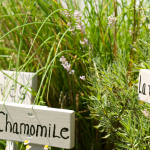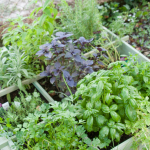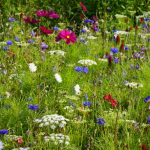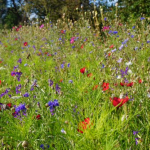Palaces for Nature: Celebrating the King’s Coronation
May 2, 2023
Whether it’s a simple pot of herbs, or a blooming marvellous mini-meadow of wildflowers, every garden can have its own crowning glory to help wildlife.
So, in honour of the coronation of King Charles III, we’re encouraging people to get green-fingered and create their own ‘Palaces for Nature.’
King Charles III maintains a reputation as a committed environmentalist, often speaking passionately on behalf of conservation causes, and taking bold action on climate change and nature loss.
 Across the South Downs, we’re working with landowners and land managers to increase the amount of land managed for nature to 33% by 2030. This will create new habitat for wildlife to survive and thrive.
Across the South Downs, we’re working with landowners and land managers to increase the amount of land managed for nature to 33% by 2030. This will create new habitat for wildlife to survive and thrive.
As the country gears up towards celebrating the Coronation of King Charles III, we know many will take the opportunity to use some of their long weekend to get to grips with those spring garden jobs.
Laura Warren, one third of The 3 Grow Bags, shares her ideas on what you can do to create ‘Palaces for Nature’ in honour King Charles.
A ‘Royal Herb Pot’
Wild herbs such as marjoram and thyme are the jewels in the crown of the chalk grassland of the South Downs National Park, being irresistible to our native bees and butterflies, and these plants are also very happy in a pot or window box so why not create your own ‘Palace for Nature’ with herbs’?
May is a perfect time as herbs will take off much better if planted as it warms up in late spring.
It’s tempting to use supermarket herb pots but their soft growth will suffer a setback if planted straight outdoors, so use properly hardened off plants from a nursery.
Choose as big a pot as you can to provide a good deep root run and add about 25% grit into a standard peat-free compost to improve its drainage.
Drought tolerant herbs
Use a mix of herbs that like the same growing conditions:
- rosemary
- thyme
- marjoram
- sage
- lavender
All like sunny conditions and are relatively drought tolerant.
Herbs for wetter soil
If you have a shadier, moister spot, you can plant the following:
- basil
- chives
- parsley
Avoid mint in either of these collections as it is too vigorous, and taller herbs too, such as dill or fennel which would look out of proportion.
You could pop in an ajuga (bugleweed) or a heuchera to give some early colour, but move them out once the herbs start to fill the pot.
A ‘Patriotic’ Pictorial Meadow
Pictorial Meadows are a specific type of flower-rich meadow mixes consisting of native and non-native species.
Each named mix has been selected for its colour, height and flowering period to produce waves of blooms throughout the summer.
As well as the uplifting visual impact, the meadows produce nectar and pollen for insects over a very long period and hibernation sites for invertebrates and seeds for birds over the winter.
Developed by Professor Nigel Dunnett of Sheffield University, Pictorial Meadows were used for the ‘Superbloom’ planting scheme around the Tower of London for the Queen’s Platinum Jubilee and are now being trialled in many urban settings to bring the joy and visual impact of meadows back into the lives of local families living in towns.
But you can also buy the mixes in small quantities for use in your own or a community garden – a 6g pack will give you 2 square meters of meadow and the ‘Patriotic Mix’ of red, white and blue seems tailor made for a ‘Palace for Nature’ to celebrate the coronation.
Ideally sown in April, this year’s cold wet spring means that you still just have time to get a patch of Pictorial Meadow sown this year, in the first week or two of May.
They’ll need an area of bare soil, just raked to prepare a seedbed with no need to dig deeply, rotovate or fertilise.
Once sown, don’t cover the seed, just press it into the surface by walking over the patch with your feet close together in a methodical way, or if it’s a larger area and you have such a thing, use a garden roller.
If it’s dry, sprinkle water gently over the site to trigger germination, then it shouldn’t ever need watering again.
The flowers will bloom in sequence over the summer, with the later blooming species rising up through the sward to mask the dying foliage of the earlier flowering species.
For more ideas on creating ‘Palaces for Nature’, including a mini-stumpery, bat palace and hedgehog highway, head to The 3 Growbags website.




